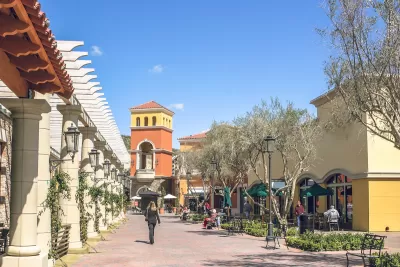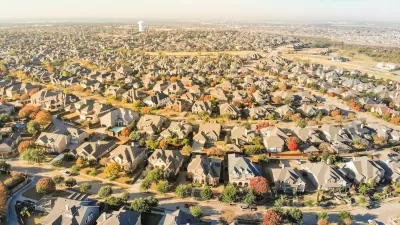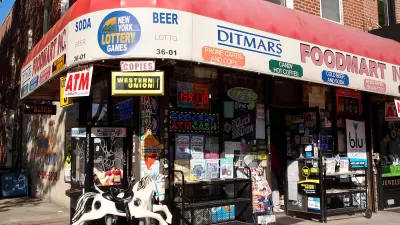Is the recent trend to build more walkable suburbs a sign of sustainable change?

Suburban developments are increasingly trying to mimic the walkability and vibrancy of urban neighborhoods, writes Alan Ehrenhalt in Governing. Is this a purely aesthetic shift, or is it a real movement toward more sustainable suburbs?
In Tempe, Arizona, 10 miles from Phoenix, a new community called Culdesac opted to remove private cars, offering access to transit, shared micromobility, and rental cars instead. According to Robert Steuteville, removing the need for car infrastructure inside the development “allows for a porous, fine-grain urban pattern with a network of narrow, shaded pedestrian-only paseos, intimate courtyards and a central plaza.” However, limited transit options mean that residents will often have to drive when leaving the community.
Ehrenhalt admits that the trend could be a blip. Lower housing costs — which could be brought on by the adaptive reuse of office buildings into residential units — could promote a stronger resurgence for urban city centers. But the strong demand for walkability among younger people is encouraging. “And if there is one thing we learned from the experience of the baby boomers, it is that when enough members of an emerging generation want something, they stand a very good chance of getting it.”
FULL STORY: A Possible Future for Downtowns Out in the Suburbs

Alabama: Trump Terminates Settlements for Black Communities Harmed By Raw Sewage
Trump deemed the landmark civil rights agreement “illegal DEI and environmental justice policy.”

Study: Maui’s Plan to Convert Vacation Rentals to Long-Term Housing Could Cause Nearly $1 Billion Economic Loss
The plan would reduce visitor accommodation by 25% resulting in 1,900 jobs lost.

Why Should We Subsidize Public Transportation?
Many public transit agencies face financial stress due to rising costs, declining fare revenue, and declining subsidies. Transit advocates must provide a strong business case for increasing public transit funding.

Paris Bike Boom Leads to Steep Drop in Air Pollution
The French city’s air quality has improved dramatically in the past 20 years, coinciding with a growth in cycling.

Why Housing Costs More to Build in California Than in Texas
Hard costs like labor and materials combined with ‘soft’ costs such as permitting make building in the San Francisco Bay Area almost three times as costly as in Texas cities.

San Diego County Sees a Rise in Urban Coyotes
San Diego County experiences a rise in urban coyotes, as sightings become prevalent throughout its urban neighbourhoods and surrounding areas.
Urban Design for Planners 1: Software Tools
This six-course series explores essential urban design concepts using open source software and equips planners with the tools they need to participate fully in the urban design process.
Planning for Universal Design
Learn the tools for implementing Universal Design in planning regulations.
Smith Gee Studio
Alamo Area Metropolitan Planning Organization
City of Santa Clarita
Institute for Housing and Urban Development Studies (IHS)
City of Grandview
Harvard GSD Executive Education
Toledo-Lucas County Plan Commissions
Salt Lake City
NYU Wagner Graduate School of Public Service





























